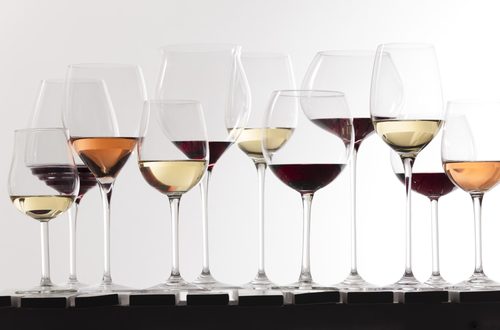As business professionals you must be armed with essential knowledge of the basic types of wine and related terminology. You’ll hear the word “varietal.” A wine varietal is the type of grape from which the wine is made. A varietal must be made of at least 51% to 75% of that grape. By California law, wine varietals must have at least 75% of the grape. As an example, a bottle labeled California Chardonnay must contain at least 75% Chardonnay grapes. Excellent wines come from different countries: France, Germany, the United States, Chile, Italy, Portugal, Spain, Australia, New Zealand and many others.
Types of Wine
- Red Wine: Red wines are great with meat, fowl and cheese. In the red wine group you will find Chianti, Barolo, Bordeaux, Burgundy, and Riolja (Rioja). Other red varietals include Pinot Noir, Cabernet Savignon, Merlot and the Zinfandels. If it’s called a Syrah, the grape was grown in either France or North America. The same red wine produced in Australia is called a Shiraz. Rich reds are served between 59ºF and 68ºF. Lighter reds are served between 54ºF and 57ºF. Rosé is a lighter red wine made from red grapes whose skins have been removed. Serve this pretty pinkcolored wine wellchilled in hot weather.
- White Wine: White wines go well with lighter foods like chicken, fish, shellfish, veal, fruit, salad and other vegetarian offerings. Serve white wines chilled. The white wine group includes Chablis, Chardonnay, Sauvignon Blanc, Chenin Blanc, White Burgundy, ChasagneMontrachet, Meursault, Mus cadet, Sancerre, Gavi, Pinot Grigio, and Rieslings. White wine is best kept in the refrigerator, at about 46ºF to 57ºF, until served.
- Appetizer Wines: Appetizer wines are premeal drinks. An apéritif is an alcoholic drink meant to stimulate the appetite before a meal. Apéritif is pronounced “ahpaireeTEEF.” Campari, Dubonnet and sweet vermouth are examples of appetizer wines and are generally served with ice in a small glass. Appetizer wines are usually served with salty peanuts or almonds.
- Dessert Wines: Dessert wines are drinks served after a meal. They may be poured either directly from the bottle or from a decanter. Sherry, Port and Madeira are wines that are called digestifs (alcohol to help digest the meal) and are served at room temperature. Sweet dessert wines like Sauternes are served chilled. Serve Sherry and Port in small apéritif or sherry glasses. Chilled dessert wines are served in white wine glasses. The perfect service temperature for dessert wines is 43ºF to 47ºF.
- Champagne and Sparkling Wines: To be called Champagne, this wine must come from the Champagne region of France. Otherwise, it’s a sparkling wine. Champagne is properly poured with the dessert course and is used for toasting at the end of a meal. It is also served as a cocktail. Both Champagne and sparkling wine are served chilled. Asti Spumante is a sparkling rosé from California. Serve Champagne and sparkling wines at temperatures of between 43ºF to 47ºF.
Wine Glasses
- White Wine Glass: Its bowl is a little smaller than that of a red wine glass because this wine does not need as much room to “breathe.” Breathing allows the aroma of the wine to be released, and connoisseurs say that it is better to concentrate the white wine’s fine bouquet in this smaller glass. Most often, white wine is served with a fish or an appetizer course. Wine traditions do evolve, and it would not be improper, in an informal setting, for you to order a glass of white or red wine with your dinner, whatever the main course. Remember to hold the white wine glass by the stem. This wine is served chilled and you do not want to warm the bowl.
- Red Wine Glass: The bowl of this glass is large in order to allow the robust aroma of a red wine to be released, or to breathe. It is a little taller than the white wine glass. Reds are often poured with the entrée (main) or meat course, although today, you will see fine reds being served with fish. You may hold this glass by its bowl or its stem since traditionally reds are served at room temperature.
- Variation of the generic red wine glass: A variation of the generic red wine class with the large bowl is the Bordeaux glass. Bordeaux wine is any wine produced in the Bordeaux region of France such as a Cabernet or a Merlot. This glass also has a large bowl, but the top of the glass is wider and turns outward to allow more air to reach the wine. This is called allowing the wine to breathe. The wine’s complex taste will be softened as it is exposed to the air. This glass directs wine to the back of the mouth. A Burgundy glass has an even larger bowl so that the aromas of delicate reds can be directed to the tip of the tongue. Burgundy wine is any wine produced in the Burgundy region of France, such as a Pinot Noir.
- Stemless Wine Glass: Some trendy and casual restaurants and bars are using nontraditional stemless red and white wine glasses. A stemless wine glass resembles a short water glass that has a rounded bottom.
- Champagne Glass: Three common Champagne glass shapes are the flute, tulip, and coupe. Experts say that glasses shaped like a “V” concentrate the bouquet of the drink. A more traditional shape is the coupe Champagne glass. It looks much like the glass serving piece in which you would receive sorbet. Champagne glasses, while remaining true to the traditional elongated shape, may also be stemless. To be called Champagne, this wine must originate from the Champagne region of France. Otherwise, it’s a sparkling wine. Champagne is properly poured with the dessert course. It is used for toasting at the end of a meal. It is also served as a cocktail. Hold this glass by the stem as both Champagne and sparkling wine are served chilled.
People will notice both your professional and personal behavior, especially at the table. Follow these simple guidelines and you will always appear polished and competent in business and social manners.
Excerpts of blog may have been taken from the book: Hospitality Management – People Skills & Manners on and off the Job. Copyright © 2015 Lyn Pont, Ph.D.
“Pont’s book is a must-read for anyone considering a career in hospitality.”
— Isadore Sharp, chairman and founder, Four Seasons Hotels and Resorts
See the book at: www.HospitalityManners.com
Visit Lyn at: www.MannersForBusiness.com
#hospitality #dining #etiquette #manners #business #wine




